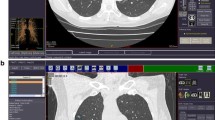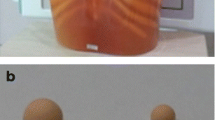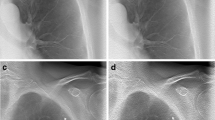Abstract
Purpose
To evaluate the diagnostic accuracy of bone suppression imaging (BSI) in the detection of pulmonary nodules on chest radiographs (CXRs) and the effect of visualization method (single or dual monitors) on diagnostic accuracy.
Materials and methods
Ten observers interpreted the CXRs of 100 patients: 50 with a T1 lung cancer nodule and 50 without nodules. Each standard CXR was first read alone and then in combination with the corresponding BSI. Two sessions of viewing were conducted: (1) the standard CXR and BSI were placed side by side on dual monitors and (2) both images were shown on the same monitor in alternation. The nodule location, confidence level, and interpretation time were recorded and analyzed statistically.
Results
When BSI was added, the area under the receiver operating characteristic curve (AUC) improved with dual monitors and a single monitor. The AUC was not significantly different between the dual-monitor and single-monitor sessions; however, the specificity with BSI and dual monitors decreased. The total interpretation time was significantly shorter with a single monitor than with dual monitors.
Conclusions
The use of BSI improved detectability of T1 lung cancer nodules on CXRs; however, specificity and reading time were affected by the visualization method.





Similar content being viewed by others

References
Austin JH, Romney BM, Goldsmith LS. Missed bronchogenic carcinoma: radiographic findings in 27 patients with a potentially resectable lesion evident in retrospect. Radiology. 1992;182:115–22.
National Lung Screening Trial Research Team. Reduced lung-cancer mortality with low-dose computed tomographic screening. N Engl J Med. 2011;365:395–409.
Nawa T, Nakagawa T, Mizoue T, Endo K. Low-dose computed tomography screening in Japan. J Thorac Imaging. 2015;30:108–14.
Stitik FP, Tockman MS. Radiographic screening in the early detection of lung cancer. Radiol Clin N Am. 1978;16:347–66.
Shah PK, Austin JH, White CS, Patel P, Haramati LB, Pearson GD, et al. Missed non-small cell lung cancer: radiographic findings of potentially resectable lesions evident only in retrospect. Radiology. 2003;226:235–41.
Monnier-Cholley L, Arrive L, Porcel A, Shehata K, Dahan H, Urban T, et al. Characteristics of missed lung cancer on chest radiographs: a French experience. Eur Radiol. 2001;11:597–605.
Suzuki K, Abe H, MacMahon H, Doi K. Image-processing technique for suppressing ribs in chest radiographs by means of massive training artificial neural network (MTANN). IEEE Trans Med Imaging. 2006;25:406–16.
Loog M, van Ginneken B, Schilham AM. Filter learning: application to suppression of bony structures from chest radiographs. Med Image Anal. 2006;10:826–40.
Li F, Hara T, Shiraishi J, Engelmann R, MacMahon H, Doi K. Improved detection of subtle lung nodules by use of chest radiographs with bone suppression imaging: receiver operating characteristic analysis with and without localization. AJR Am J Roentgenol. 2011;196:W535–W541541.
Miyoshi T, Yoshida J, Aramaki N, Matsumura Y, Aokage K, Hishida T, et al. Effectiveness of bone suppression imaging in the detection of lung nodules on chest radiographs: relevance to anatomic location and observer's experience. J Thorac Imaging. 2017;32:398–405.
Freedman MT, Lo SC, Seibel JC, Bromley CM. Lung nodules: improved detection with software that suppresses the rib and clavicle on chest radiographs. Radiology. 2011;260:265–73.
Li F, Engelmann R, Pesce LL, Doi K, Metz CE, Macmahon H. Small lung cancers: improved detection by use of bone suppression imaging–comparison with dual-energy subtraction chest radiography. Radiology. 2011;261:937–49.
Sakai S, Soeda H, Takahashi N, Okafuji T, Yoshitake T, et al. Computer-aided nodule detection on digital chest radiography: validation test on consecutive T1 cases of resectable lung cancer. J Digit Imaging. 2006;19:376–82.
Gohagan JK, Marcus PM, Fagerstrom RM, Pinsky PF, Kramer BS, Prorok PC, et al. Final results of the lung screening study, a randomized feasibility study of spiral CT versus chest X-ray screening for lung cancer. Lung Cancer. 2005;47:9–15.
van Beek EJ, Mullan B, Thompson B. Evaluation of a real-time interactive pulmonary nodule analysis system on chest digital radiographic images: a prospective study. Acad Radiol. 2008;15:571–5.
Krupinski EA, Evanoff M, Ovitt T, Standen JR, Chu TX, Johnson J. Influence of image processing on chest radiograph interpretation and decision changes. Acad Radiol. 1998;5:79–85.
Szucs-Farkas Z, Patak MA, Yuksel-Hatz S, Ruder T, Vock P. Single-exposure dual-energy subtraction chest radiography: detection of pulmonary nodules and masses in clinical practice. Eur Radiol. 2008;18:24–31.
Funding
This research did not receive any specific grant from funding agencies in the public, commercial, or not-for-profit sectors.
Author information
Authors and Affiliations
Corresponding author
Ethics declarations
Conflict of interest
The authors have that they have no conflicts of interest.
Ethical statement
The Institutional Review Board approved this study. The requirement for informed consent was waived because it was a retrospective study.
Informed consent
This retrospective, single-institution study was approved by an institutional review board of our facility. Written informed consent for the inclusion of individual patient data in the analysis was waived because of the retrospective nature of the investigation.
Additional information
Publisher's Note
Springer Nature remains neutral with regard to jurisdictional claims in published maps and institutional affiliations.
About this article
Cite this article
Endo, K., Kaneko, A., Horiuchi, Y. et al. Detectability of pulmonary nodules on chest radiographs: bone suppression versus standard technique with single versus dual monitors for visualization. Jpn J Radiol 38, 676–682 (2020). https://doi.org/10.1007/s11604-020-00952-2
Received:
Accepted:
Published:
Issue Date:
DOI: https://doi.org/10.1007/s11604-020-00952-2



